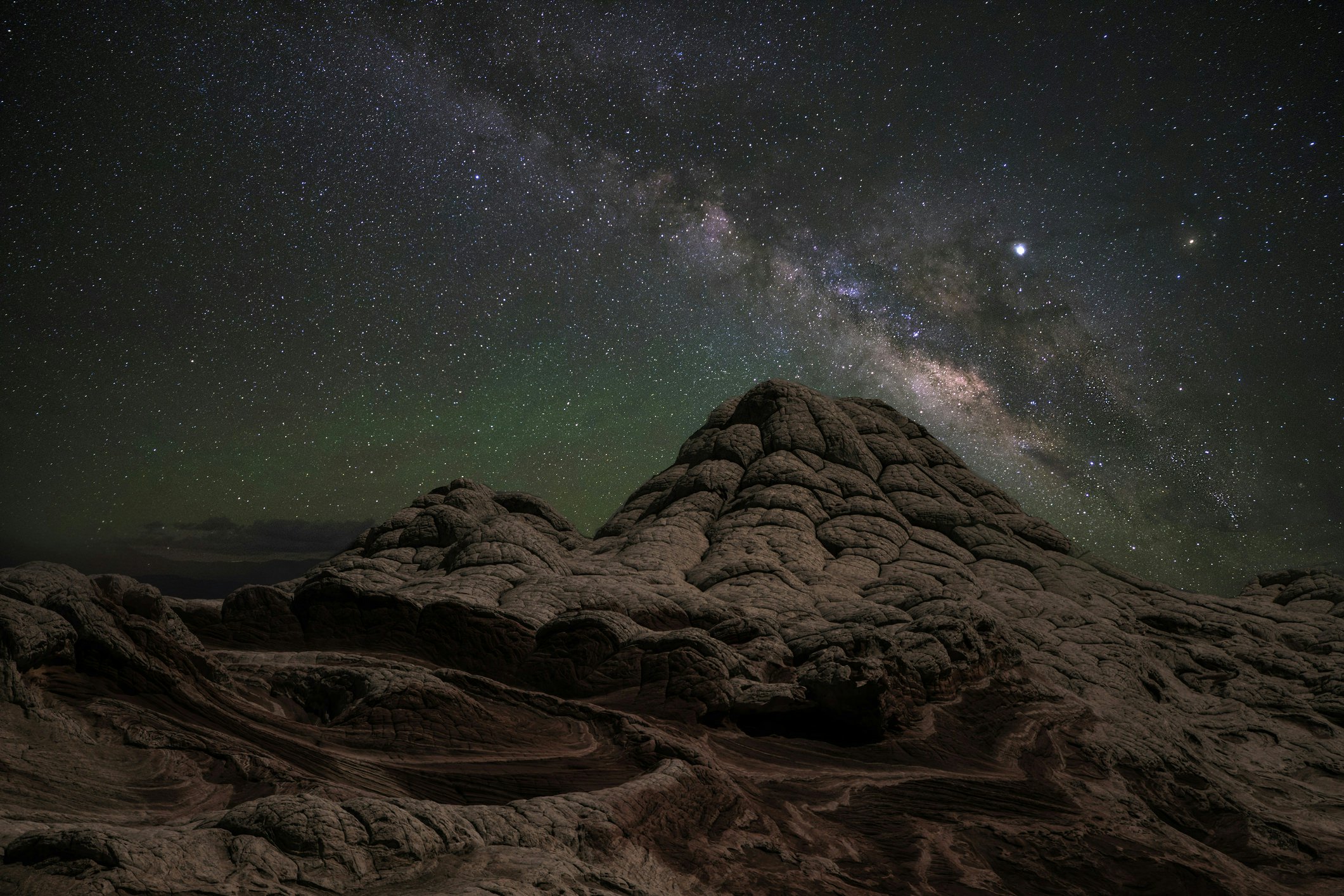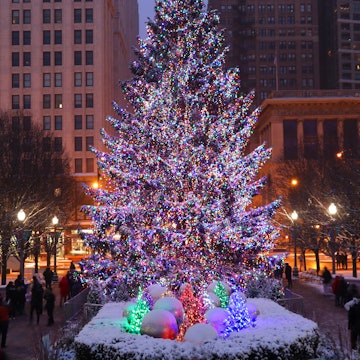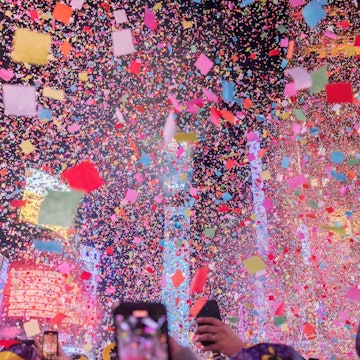
Astrotourists love these Dark Sky Communities for urban stargazing
Jan 7, 2020 • 7 min read

The Milky Way is harder and harder to see for most Americans, but shines bright in Sedona, Arizona. Robert Loe / Getty Images
Though we have mapped and explored some of Earth's most far-flung destinations, the stars above remain out of reach. The night sky still fascinates, inviting us to wonder at the mysterious Milky Way and trace the ancient stories spelled out in constellations. It's possible to look up from wherever we are each night. But as light pollution creeps across the globe, many travelers seek the world's dark corners, where celestial sights still glow bright. It's no wonder that astrotourism is on the rise.
In 2001, the International Dark-Sky Association (IDA) began the International Dark Sky Places (IDSP) Program, designating communities, parks and protected areas around the world that are actively working to decrease light pollution and preserve night sky visibility. While there are 120 rural or exurban parks, reserves, and sanctuaries worldwide that have earned IDA recognition, there are also select Dark Sky Communities (DSC) that qualify thanks to stringent tests measuring outdoor light pollution and local dark sky education efforts.
There are fewer than 20 Dark Sky Communities in the United States where you can escape the crowds, glare, and skyglow of major cities while still staying in reach of traveler comforts like hotels, dining options, and other vacation luxuries. We rounded up ten of the best where you can enjoy a day trip to a week-long getaway to take in unadulterated views of the twinkling canopy above.

Flagstaff, Arizona
In 2001, Flagstaff became the world’s first International Dark Sky City, a recognition of early efforts like a 1958 ordinance passed to protect against light pollution – one of the first such laws in the world. From Buffalo Park and Anderson Mesa to Sunset Crater National Monument and U.S. Naval Observatory Flagstaff Station, there’s no shortage of places to stop and see the stars in this charming city just south of Arizona's San Francisco Peaks.
But a trip to Flagstaff doesn’t begin with the night sky. Don’t miss a chance to see where Pluto was discovered during a tour of Lowell Observatory. Next, drive out to the mile-wide Meteor Crater, possibly the most preserved meteorite impact destination on the planet.
Beverly Shores, Indiana
With a population of about 600, Beverly Shores, Indiana makes up in starlight what it lacks in luxury accommodation and dining. Surrounded on three sides by Indiana Dunes National Park (one of America's newest national parks), the town is a spit of residential area along Indiana’s Lake Michigan shoreline. It’s an easy hour drive south from Chicago, though it’s also accessible via the South Shore rail line. In winter months, starlight glitters over the frosty lake surface as early as 4:30 PM, while summer is ideal for late-night picnics and stargazing on the beach.
Verde Valley, Arizona
The red rocks and energy vortexes of Arizona's Verde Valley have long been touted as paradise for hikers and spiritual seekers by day, but also dazzle with primal celestial beauty at night. The Verde Valley boasts four Dark Sky Communities with their own unique stargazing spots, and while you’re unlikely to get a glimpse of the Northern Lights this far south, the area soothes with its own unique energy.
The first Dark Sky Community here is near Sedona, where you can look to the skies from Two Trees Observing Area off of route 89A. Another is near the Village of Oak Creek, which sits just north of Red Rock Country in the Coconino National Forest. Drive along Verde Valley School Road for a journey under the stars – you can park at numerous trailheads along the way for stunning views.
In Campe Verde, spend the night in a bubble-like stargazing capsule where you can cozily observe the night sky from a full-size bed and fall asleep under the twinkling lights. Or you can head to Cottonwood, grab a blanket and trek into Verde River Greenway State Natural Area. This spot is frequented by astronomy clubs and is the setting for star parties year round where you can meet fellow dark sky fans.
Dripping Springs, Texas
Known as the Gateway to Hill Country, Texas' Dripping Springs is the perfect weekend getaway from bustling Austin. Hit the trails during the day, then grab a telescope at night. Don’t miss Hamilton Pool Preserve, a waterfall-fed natural swimming hole where you can cool off depending on the time of year.
Dripping Springs was the first Dark Sky Community in Texas, which inspired nearby Wimberley Valley and Horseshoe Bay to preserve their night skies, too. But Dripping Springs’ commitment to the dark is about more than attracting stargazers – the lack of light pollution also preserves this old ranching town’s time-honored tradition of star-spangled nights spent around the campfire.

Norwood, Colorado
Tucked away in a remote corner of southern Colorado’s high desert, just an hour-long drive from the booming ski town of Telluride, Norwood’s combination of dry air and inky night skies is a stargazer’s dream. In many parts of the country, a humid haze can appear to smudge or even obscure constellations. But in Norwood you will stand in awe of the crystal-clear sparkling canopy of stars above.

Borrego Springs, California
The only California town completely surrounded by a state park, Borrego Springs is bastion of civilization for anyone weary of solitude in Anza-Borrego Desert. Road trippers can rest their heads at the Springs at Borrego, a local RV resort, after a late night of basking in the glow of the Milky Way. The resort has a small telescope-equipped observatory for curious campers. Or, if you prefer a guided tour of the night sky, California Overland offers overnight camping trips —telescopes, gear, meals, and local astronomers included.

Torrey, Utah
After Capitol Reef National Park was named an International Dark Sky Park in 2015, it made sense for the park’s gateway town, Torrey, to shoot for the stars too. Now the entire area transforms into a starlit natural wonderland each night. After a stargazing night in Torrey, continue your adventure by taking Highway 24 into the Fruita Rural Historic District. Initially settled in the 1880s, Fruita still blooms with heirloom apricot trees left behind by a handful of pioneers. When the fruit is ripe, visitors are welcome to wander the orchards pluck a tasty trail snack for hikes on sunny Hickman Bridge Trail or Gooseneck Overlook.

Ketchum, Idaho
Enfolded in the ski slopes of Idaho’s Rocky Mountains, Ketchum offers a plethora of pre-stargazing adventures year-round. Rivers cascading down craggy peaks tempt fly fishers, white water rafters, and adrenaline-fueled hikers in the warmer months. In winter, the slopes woo skiers of all experience to fly down the slopes of the Sawtooth Mountains.
However you spend your days, once the sun sets in the Central Idaho Dark Sky Reserve – which also includes the nearby town of Sun Valley – the stars take center stage. Astrophotographers flock to the area to capture comets, meteors, and the effervescent Milky Way. Head to locations like Knob Hill, Sun Valley Lake, and Redfish Lake for some of the best views and bonus reflections in still mountain waters.

Thunder Mountain Pootseev Nightsky
To visit Thunder Mountain Pootseev Nightsky is to step into a one-of-the-kind wonder. This Dark Sky Community encompasses all of the Kaibab Paiute Indian Reservation, making it also the world’s first and only dark sky nation. And because the Reservation border sits about 50 miles north of Grand Canyon National Park, it's an easy addition to another iconic destination.
For a day trip from the Grand Canyon, take either 89-N or 67-N toward Vermilion Cliffs National Monument. Explore the majestic scenery in daylight, but leave time to explore Pipe Springs National Monument before sunset, where you can learn more about the Indigenous and Mormon history of this place. After the stars come out, spot Mercury, Mars, and Jupiter, then make camp at Kaibab Paiute RV Park & Campground.
Homer Glen, Illinois
Only 30 miles south of Chicago, Homer Glen is an oasis of calm compared to the bright lights of the city. Start the day at the Adler Planetarium, watch stars on stage at one of Chicago’s Broadway productions, then head to Homer Glen for an evening under the celestial stage above. Since Illinois experiences all four seasons, stargazing in Homer Glen is best in winter, when crisp nights invite clear skies – just don't forget warm clothes and a blanket.















